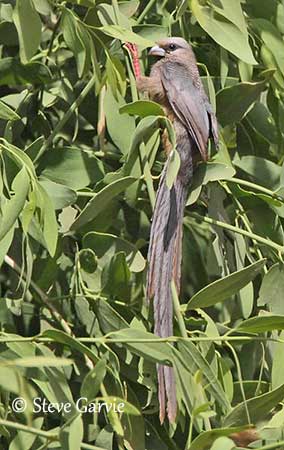
Page under
copyright !
TO BE CONTINUED... Page 14
Text by Nicole Bouglouan
Photographers:
Didier Buysse
Vision d’Oiseaux
Steve Garvie
RAINBIRDER Photo galleries & Flickr Rainbirder
Tom Grey
Tom Grey's Bird Pictures & Tom Grey's Bird Pictures 2
William Price
PBase-tereksandpiper & Flickr William Price
Dubi Shapiro
Dubi Shapiro Photo Galleries
Ingo Waschkies
Bird Photography
Philippe and Aline Wolfer
OISEAUX D'ARGENTINE
These images and the text are subject to copyright and cannot be used without express authorization from the owners. Legal issues
Sources :
HANDBOOK OF THE BIRDS OF THE WORLD Vol 6 by Josep del Hoyo-Andrew Elliott-Jordi Sargatal - Lynx Edicions, 2001 - ISBN: 848733430X
L’ENCYCLOPEDIE MONDIALE DES OISEAUX - Dr Christopher M. Perrins - BORDAS - ISBN: 2040185607
Wikipedia, the free encyclopaedia
Bird nests: Variety is Key for the world’s avian Architects
Be on the lookout for bird nests
The design and function of birds' nests
The bird and its nest, where everything starts…
Page 13: Coliidae, Trogonidae, Leptosomidae
At the beginning of the breeding season and following several courtship displays, the nest-site is selected by the pair, or one of the members of the pair, and the nest is built within this area. For numerous species, the nest is the place where displays and copulation occur. It plays a very important role during the nesting period. It is the cradle of the chicks, the place where the adults feed them prior to their first flight towards independence.
The family Coliidae in the order Coliiformes includes small to medium-sized arboreal birds with generally dull grey or brown plumage. Their distribution is exclusively African. Six species placed in two genera, Colius and Urocolius, are known as mousebirds. This name comes from their creeping movements through the vegetation, recalling those of small rodents.
The mousebirds have small body and long tail of about 2/3 of the bird length of some 30-35 centimetres. The erectile crest is usually fanned. As arboreal species, they have short legs with large toes which can all be directed forwards, and strong, sharp, hooked claws. The slightly decurved bill is short and robust.

They are primarily frugivorous and spend long time foraging in dense foliage. They move with great agility, often hanging upside-down. They also feed on leaves, shoots, buds, flowers and nectar, providing them sufficient water. However, when they do drink, they suck the water like the Columbidae, instead of raising the head to swallow each mouthful.
Mousebirds are gregarious birds and occur in flocks throughout the year, including during the breeding season. Their nests are often found close together in loose colonies usually associated with local abundance of fruit. The pairs are monogamous with long term pair bonds with some exceptions such as the Speckled Mousebird which may have helpers. In this case, they help in nest-building, incubating and rearing the young.
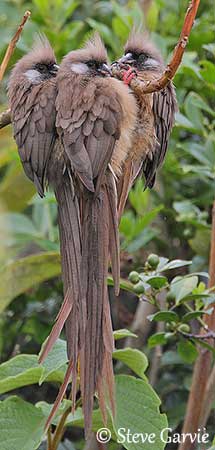
The breeding period is more or less related to food availability, but the breeding attempts may occur throughout the year. Various calls, mutual preening and courtship feeding may be attributed to courtship. Some behaviour involves both male and female moving rhythmically up and down while perched on a branch or on the ground. They also may leap up to four centimetres in the air. Copulation often follows these displays.
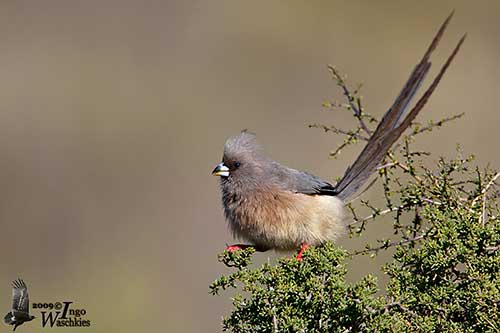
The mousebirds nets in trees or bushes, between 1 and 7 metres above the ground. They build a nest similar to the passerine’s nests, an open cup with basal platform and soft lining. The two species of genus Urocolius build the nest with dry, branched and often thorny twigs, whereas other species include green stems and other flexible plant material in the structure. The lining is made with softer material such as grasses, leaves, mosses, lichens, hair, wool, spider webs, but also paper or string near human habitations. The birds add green leaves to the lining when eggs or chicks are present. The nest is well hidden in the vegetation, and some external decoration is used as camouflage. The thorny twigs used to build the nest provide a good protection.
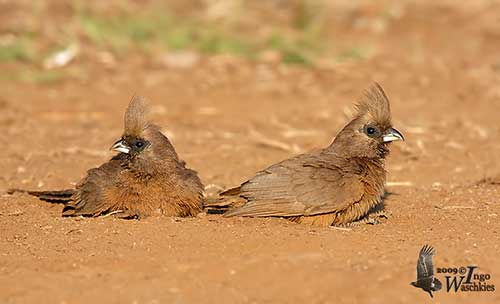
Both parents share the nesting duties, sometimes with helpers. The two or three chicks are fed by regurgitation. They young are able to creep out of the nest ten days after hatching, and they are still fed during 4-6 weeks.
Many nests are destroyed by rain or wind, or by predators including both birds and snakes, and the breeding success is quite low. However, the mousebirds are common to very common in Africa, and currently not globally threatened.
The family Trogonidae in the order Trogoniformes includes more than 40 species classified in three subfamilies separating the African, American and Asian trogon species.
These arboreal birds have compact body with short neck, but they have a long, graduated tail and short wings. The broad bill is hooked. The short legs and the branch-gripping feet with toes in pairs are well adapted to the life in trees. They come to the ground only to catch a prey and most of them are not able to walk.
The African and American trogons have green and blue upperparts, whereas the Asian species are mostly bright brown above. The densely barred or vermiculated wing panel, white on black in males and buff on black in females, may be used in species recognition. The underparts are usually red, pink, orange or yellow.
The large eyes allow the birds to hunt in dark areas of the subcanopy of the trees. Nostril and bill base are concealed with well-developed rictal bristles.
The male Resplendent Quetzal shows long tail-streamers and laterally compressed, helmet-like crest extending forwards and covering the base of the bill.
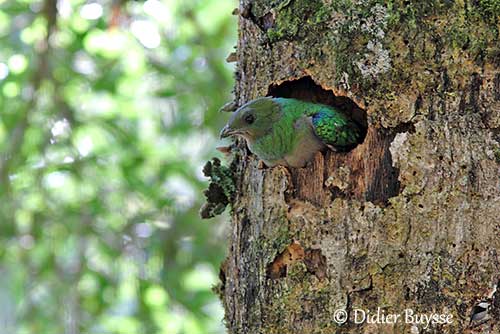
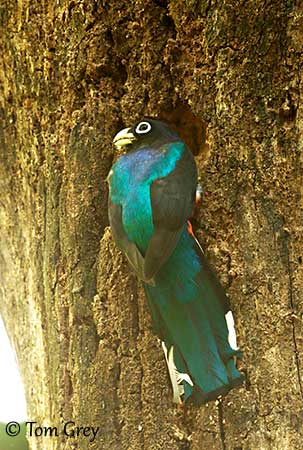
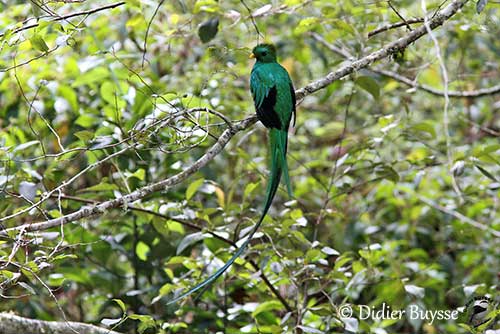
The Trogonidae are mainly forest birds. They frequent the middle strata and shady interior of woodland, and may sometimes enter the canopy. They can be seen perched upright on horizontal branches.
The African trogons are exclusively insect-eaters or carnivorous, but the Asian species takes animal food and mainly fruit. The American trogons also take animal food and fruit, but in variable proportions, although the quetzals are almost exclusively insectivorous. Insectivorous trogons tend to be territorial all year round, while the frugivorous species travel in small groups according to food availability.
They forage in flight, hovering briefly or momentarily stall to pick a food item off foliage, bark or stem, or to pluck a fruit from bush or tree. The broadly spread tail helps the birds to keep the balance and control the stall. They may pursue insects in flight at forest edges, or they land briefly to snatch up a prey before to eat it on a perch.
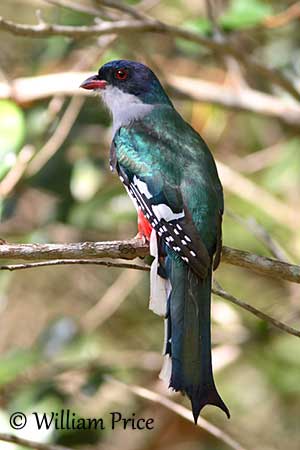
Male trogons are territorial and defend the nest-site against predators with a direct flight at the intruder while calling. They are monogamous and both mates share the nesting duties.
Some displays are done in groups that are not leks. The Resplendent Quetzal uses these groups to find a mate, and several males can be seen pursuing a single female by flying from branch to branch. However, many species maintain a loose association and re-mate in the following season.
Baird's Trogon
Excavating the cavity
Trogonidae are cavity-nesters and use various types of cavities such as holes in trees or in nests of social insects, or holes in the roots of epiphytes, or they excavate cacti and tree-fern trunks. They have to find wood of just the proper firmness to properly excavate the hole. The birds may sometimes excavate several holes because the wood is too rotten. This work may last several months and both mates share the nest-building.
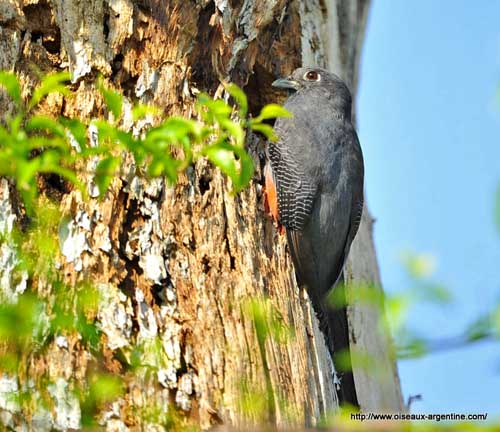
Female at nest entrance
The cavity may have upward-slanting entrance tubes leading to fully enclosed chambers and the incubating parent is totally concealed. Other species including quetzals, build shallower, more open niches, involving visible head or tail outside the entrance. There is no evidence of lining within the cavity.
Female at nest entrance
The trogons lay 2-4 rounded eggs that become very dirty as the incubation is progressing. Both adults share the incubation that may last from 16 to 19 days. The nestling period lasts 15-17 days, although the larger Resplendent Quetzal needs at least 23 to 30 days. The chicks are blind and naked and are fed by both parents. The nests are usually dirty, and the bottom of the cavity is often wet as the dejections are accumulating, and a repugnant odour attracts flies, but may also act as protection against predators.
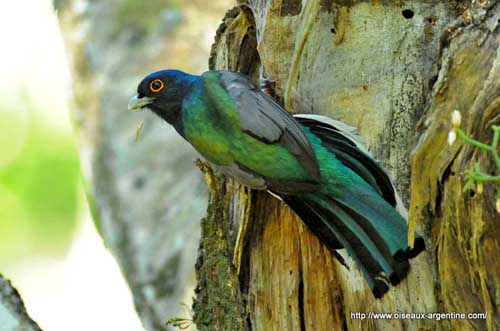
Male at nest entrance
Trogons are threatened by deforestation and forest clearance, but they are relatively common birds. They are very sensitive to human disturbance during the breeding season, and the Resplendent Quetzal is the most threatened species, because the tourism industry related to this beautiful species is very lucrative.
The family Leptosomidae in the order Leptosomiformes includes only one species, the Cuckoo Roller. This arboreal bird is medium-sized but it has a heavy body and a disproportionally large head, whereas the legs are short and delicate. The wings are long and broad, and the tail is moderately long. The eyes are placed far back on the head. The stout bill has broad base, and the tip is slightly hooked and serrated. The feet are not described as zygodactyl although the bird perches with two toes forwards and tow toes backwards.
The male has grey head with thin black band through the eye and black top of head. Back, upperwing-coverts and tail are metallic greenish with violet sheen, and the underparts are grey and white. The flight-feathers are dark blue, whereas the underwing is white with dark wingtip. Legs and feet are brown to pale orange. The eyes are brown. The bill is blackish.
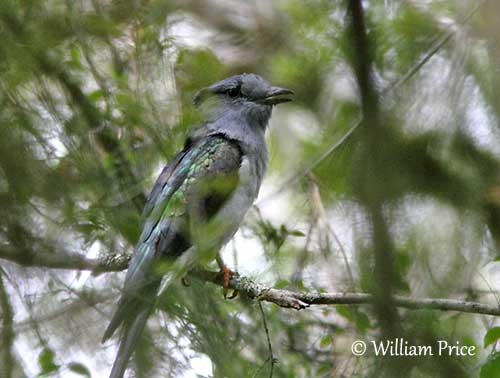
The female is very different, with brown head and neck with dark barring. The upperparts including back, upperwing-coverts and tail are dark brown with chestnut markings. The underparts are white to buff with conspicuous and irregular dark brown spotting. The throat is tinged brown.
The juvenile is probably duller than the female.
Three subspecies are recognized, with L.d. gracilis in Grand Comoro, L.d. intermedius on Anjouan, and the nominate race L.d. discolor in Madagascar, Mohéli and Mayotte.
The Cuckoo Roller frequents a wide variety of habitats, including man-made zones. It can be found in rainforest, coastal, gallery and deciduous forests, spiny bush-forest and tree plantations, and in open habitats up to 2,000 metres of elevation. It needs at least areas with large trees.
It feeds on various invertebrates but mainly insects, and also takes reptiles and especially chameleons. It forages by perching motionless in upper forest canopy, watching and waiting, making a short sally as soon as a prey is detected. It also performs active aerial foraging high in the canopy of the forest. The prey is caught with the strong bill.
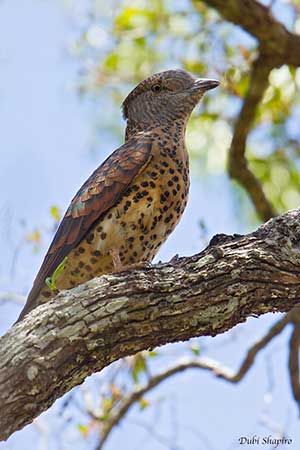
The Cuckoo Roller is probably monogamous. They perform aerial displays in groups of up to ten birds flying above the canopy while uttering a piercing “dree-o” call three times.
This species nests in natural tree cavity placed about 4-6 metres above the ground. The lining is absent, even in the nest chamber.
The female lays 4-5 whitish eggs directly on to the bottom of the hole. She incubates during at least 20 days and the male feeds her during this period. The chicks have long white down and fledge about one month after hatching. They are fed mainly by the female, but more information is required about the male’s participation.
The cavity has strong musky smell, but the adults do not remove the dejections of the young birds.
The Cuckoo Roller is preyed upon by lemurs, snakes and by the Madagascar Harrier-Hawk. It is widespread in suitable habitats but mostly patchily distributed and uncommon in other areas. Destruction of forest is a major threat, but currently, the species does not appear globally threatened.